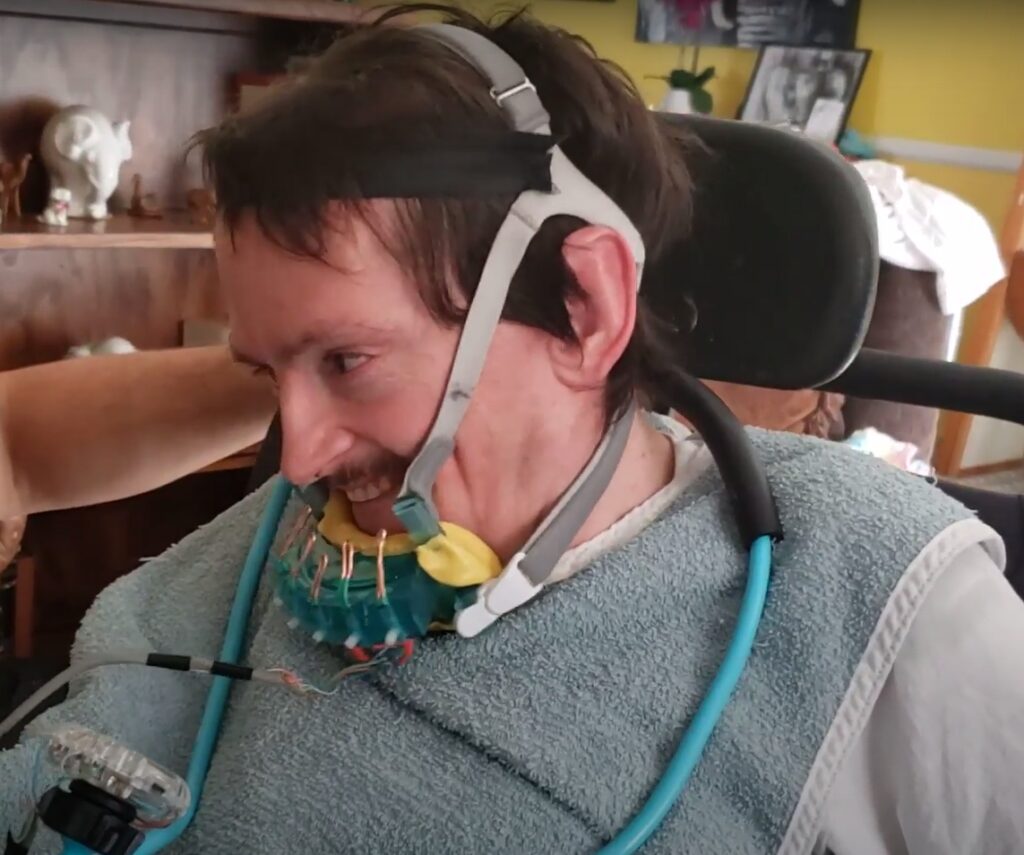UCSD Team Offers Engineering with a Touch of Love
by Sheryl Wilde
Science can amuse and fascinate us all, but it is engineering that changes the world. ~Isaac Asimov
Most of you already know Mountain Shadows is a heaven-on-earth kind of place where angels dwell and miracles happen daily, but we must admit sometimes we are still simply filled with awe and wonder at stories like this.
“Stacy was overjoyed!” The words of Portia, Stacy’s mom, bubbled over with excitement and gratitude when the UCSD student engineering team visited the Bibb home.
Many of you may know Stacy as well. He’s been a resident at Mountain Shadows since 1986. Stacy has athetoid cerebral palsy and, at age 47, he weighs 80 pounds, has the developmental abilities of a 4-month-old, and the mental capacity of a 12-year-old. He’s quadriplegic and can’t walk, talk, or hold up his head by himself.
You may ask, “What could fill someone like Stacy with so much joy?”
Well, the answer is as simple as it is profound: A UCSD team of undergraduate mechanical engineers that combine innovation with love to help change people’s lives – in this case, Stacy’s life, for the better.
The Background
Stacy has used several iterations of a tongue-touch keypad (TTK) for more than 25 years. The device allows him to control a mouse and keyboard with the touch of his tongue, one of the only functioning muscles in his body.
The TTK device he’d been using stopped working. Without it, his only method of communication was to stick out his tongue or close his mouth to say ‘yes’ or ‘no’.
Jason Eldred, a friend of the Bibb family, and a professional game designer, came up with the idea of creating a tongue-controlled device that was based on capacitive touch and mounted around the chin. He designed an interim device ([click here to view story](https://conta.cc/3sXs0qs)) which got Stacy back online. In the hope of expanding on the device’s capabilities, Jason contacted Nate Delson, a friend of Portia’s who holds a PhD in Mechanical Engineering from MIT and is currently the Senior Teaching Professor in the Department of Mechanical and Aerospace Engineering at UCSD.
Each year, mechanical engineering undergraduates are asked to select a custom project to design from beginning to end. Five UCSD students chose to work on Stacy’s TTK device.
The UCSD “Ingenium” TTK Device
Professor Nate Delson was the engineering course instructor for the project. “The students showed a large sense of commitment in working on this project. They were working for more than a grade. They have seen first-hand the potential of using engineering for good, and how it can make real changes in people’s lives.”
The teams’ final design is a wearable chin guard device, “The Ingenium”, that utilizes CPAP head and forehead straps, copper wires, CAT5 ethernet cable and an Adafruit CPB board powered by a computer via a USB cable. The Adafruit CPB board synthesizes signals received from the CAT5 ethernet cable.
When Stacy touches one of the copper wire contact points with his tongue, depending on which contact point is touched, the Adafruit CPB board executes specific commands that allow him to control a computer.
Says Nate, “The device allows Stacy to move the cursor on his computer, play games, and type messages by moving his tongue and touching one of the wires.”
Says UCSD student team member, Punit, “I chose this project because I wanted to help Stacy out. I learned a lot about the iteration process. In working on a project like this, a lot can and will go wrong. We learned to use patience to work around problems.”
Team member Garrett adds, “My brother is special needs, so I know the struggles that can be involved. I chose this project because I really want to help the disabled. I learned how much a small thing like this could help someone.
“This device made a world of difference for Stacy and his family. Stacy worked hard. He had a hunger to learn. It felt good to do something that mattered. Doing an engineering project for a big company often just helps their bottom line. Doing a project for a family like this helps make lives better.”
Team member Huan agrees, “Stacy’s project was my first choice, because I could clearly see that what we were doing was helping someone. That’s really important for engineering.
“There were challenges since Stacy couldn’t talk to us. We worked with Portia and Jason to understand his needs. We had to look at him to see if he was happy. As engineers, we must look at customer needs all the time.
“Our first prototype used metal tabs as contact points and they were sharp and dug into Stacy’s nose. We adjusted and used wire contacts rather than tabs. They didn’t hurt him. Stacy’s needs were the most important thing in creating this. Modifications to meet his needs were the most essential part.”
The UCSD – Stacy Bibb Team placed in the top five, out of 36 projects, in the Spring 2021 Best Project Awards.
“I am overwhelmed with the students’ commitment, professionalism, and rocking results!” says Portia.
Our thanks to Jason Eldred, Professor Nate Delson and the entire UCSD student team for their exceptional and heart-felt dedication to this project and to changing the world through engineering innovation. Through your work, you brought joy to Stacy and his family – and made their lives better!
Learn more about the UCSD team’s project: [https://sites.google.com/eng.ucsd.edu/156b-team08-spring-2021/](https://sites.google.com/eng.ucsd.edu/156b-team08-spring-2021/)


